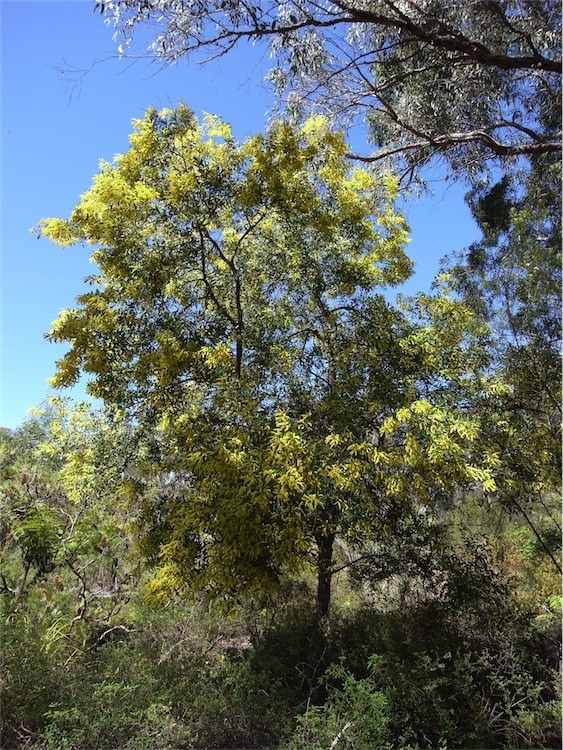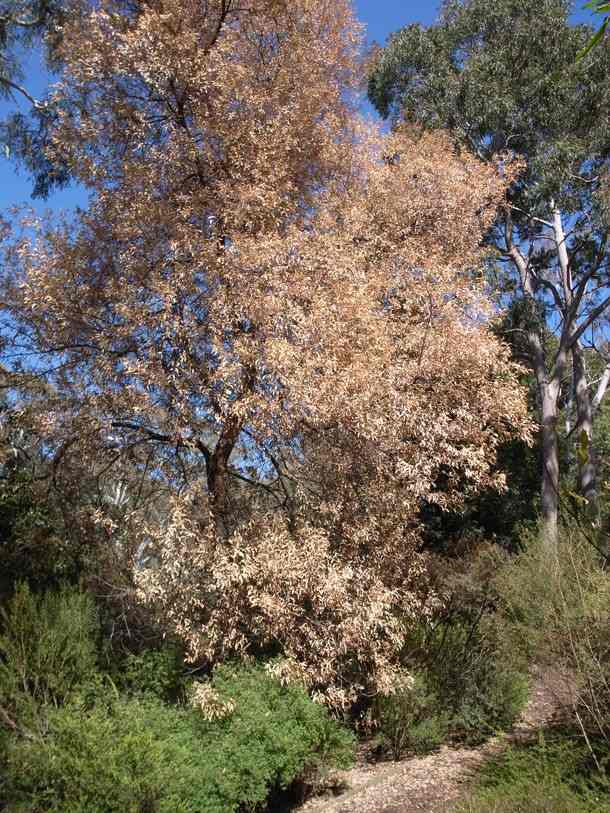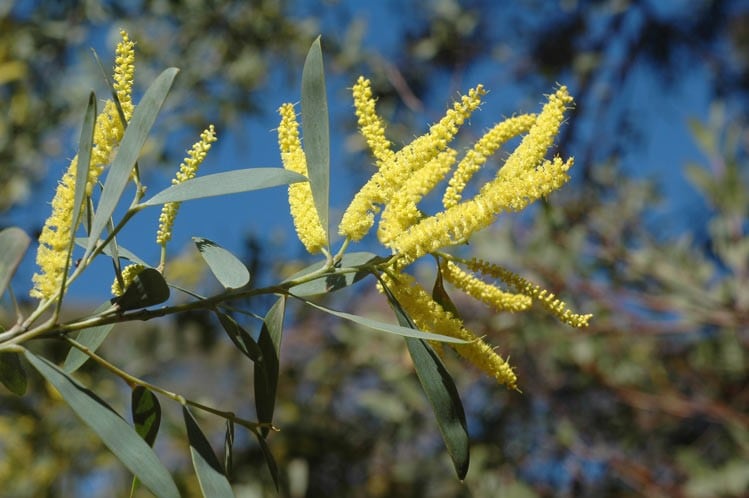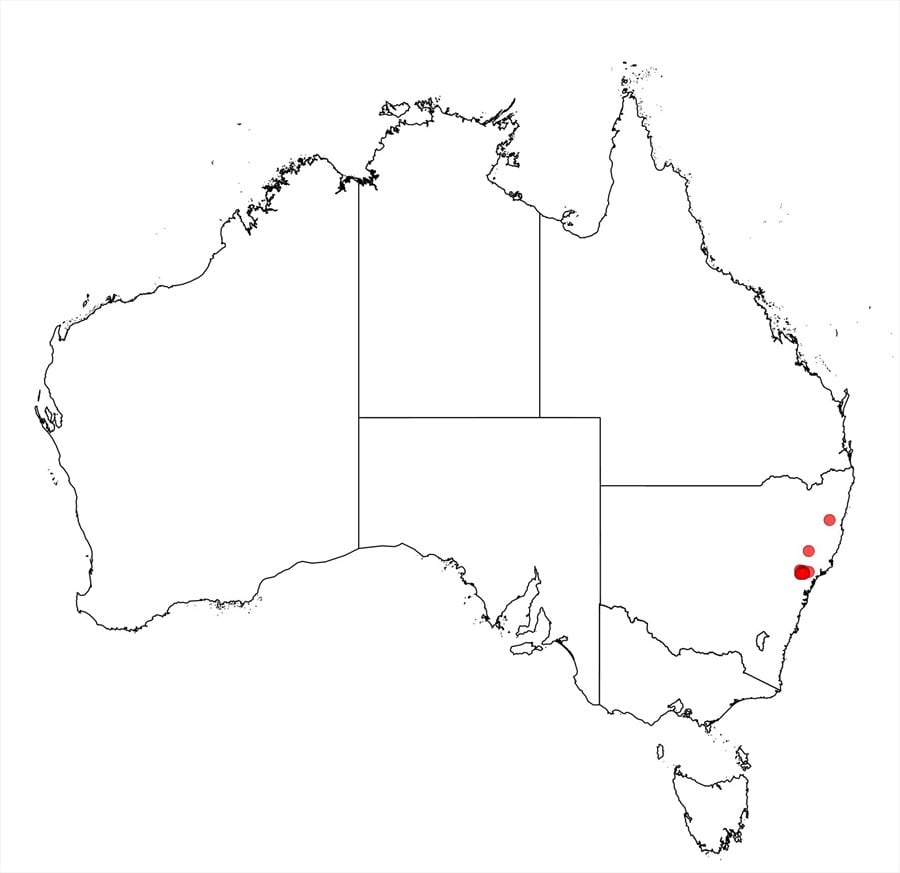Acacia bulgaensis Tindale & S.Davies
WATTLE
Acacias of Australia
Common Name
Bulga Wattle
Family
Fabaceae
Distribution
Restricted in the Hunter Valley from near Bulga, Milbrodale and Broke, N.S.W.
Description
Shrub or small tree, 1.5–8 m high. Bark peeling in short flakes, fibrous below, grey-brown, dark brown or reddish brown. Branchlets not markedly triquetrous, becoming terete, light brown to reddish brown, glabrous, often pruinose. Mature phyllodes mostly narrowly elliptic to very narrowly elliptic, usually scarcely curved, 3.5–10 cm long, 7–15 (–23) mm wide, with acute apex and subglobose mucro, coriaceous, glabrous (young growth reddish black and viscid), often glaucous, with 3 obscure or subprominent longitudinal nerves separate to base, mostly with 4–7 nonanastomosing minor nerves per mm; gland inconspicuous, basal; pulvinus 1.4–3 mm long. Inflorescences racemose; raceme axes (1–) 3–9 (–12) mm long. Spikes 2, sometimes 1 on leafy axillary shoot, 3–5.2 cm long, dense, bright yellow. Flowers 5-merous; calyx 0.4–0.7 mm long, nearly truncate or dissected to 1/5, densely pubescent to villous, not scurfy; corolla 1.5–1.8 mm long, dissected to c. 1/3; petals acute, glabrous; ovary glabrous. Pods linear, submoniliform, flat or almost so, straight or curved, 2–9.5 cm long, 3–5 mm wide, thinly coriaceous, finely striate, glabrous. Seeds longitudinal, 4–5 mm long, dark brown to black; areole open.
Phenology
Flowers: Sept.–Mar.; fruits: Oct.–Mar.
Habitat
Grows in hilly sandstone country, sometimes on shale, in eucalypt open forest.
Specimens
N.S.W.: 8.5 km SW of Bulga, 24.2 km SW of Singleton, R.G.Coveny 3928 & K.Thurtell (A, AD, B, BRI, CANB, HO, K, LE, MEL, NA, NE, NSW, NU, PERTH, TNS, UC, US, Z); Darkey Ck, 142 km N of Windsor–Singleton road, 12.9 km SW of Bulga, R.G.Coveny 4110 & R.Bisby (A, B, BRI, CANB, K, L, NSW, US); 1 km E of Milbrodale on Broke road, R.G.Coveny 9095 & P.Hind (AD, BM, BRI, CANB, MEL, MO, NSW, PERTH, UC); E of Bulga, Hunter Valley, R.Story 6735 (NSW).
Notes
This species is is a member of the ‘A. cheelii group’ and distinguished from the related A. matthewii by being a smaller tree or shrub, with less peeling bark, smaller, less curved, glaucous phyllodes with less prominent main nerves and shorter pulvini, branchlets that are often pruinose, not so deeply angular, not winged, and soon terete, shorter bracteole claws, mostly shorter calyces with slightly shorter, less spreading hairs and without red-brown or black glandular hairs at the apices, mostly shorter, not scurfy corollas, glabrous ovaries, and seeds with a longer areole that is narrower at the opening.
FOA Reference
Data derived from Flora of Australia Volumes 11A (2001), 11B (2001) and 12 (1998), products of ABRS, ©Commonwealth of Australia
Author
Minor edits by B.R.Maslin
M.D.Tindale, P.G.Kodela
This identification key and fact sheets are available as a mobile application:
URL: https://apps.lucidcentral.org/wattle/
© Copyright 2018. All rights reserved.












